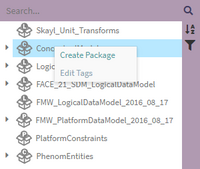Package: Difference between revisions
(Created page with "== A Primer on Packages == Packages function like folders that help users organize elements of the project. Each package has a type: * Conceptual * Logical * Platform * Service (UoP) * Integration * Deployment The type of the package limits the scope of elements it can contain: Conceptual packages can contain only Observables, Entities, and Associations; Logical packages can contain only Measurements, Measurement Systems, Coordinate Systems...; etc. Each package may also...") |
No edit summary |
||
| Line 13: | Line 13: | ||
== Creating Packages == | == Creating Packages == | ||
To create a package, either select the corresponding option in the Create dropdown menu or right-click on a package in the NavTree. | To create a package, the user needs to either select the corresponding option in the Create dropdown menu or right-click on a package in the NavTree. | ||
[[File:Phenom-data model-details package create.png|1200px|border]] <br><br> | [[File:Phenom-data model-details package create.png|1200px|border]] <br><br> | ||
[[File:Phenom-data model-details package create navtree.png|200px|border]] | [[File:Phenom-data model-details package create navtree.png|200px|border]] | ||
The user needs fill in the Package's name (which must be unique) and description. | |||
If the user right-clicked on a package from the NavTree, the type and parent package will be pre-filled with the selected package. If not, the user needs to select a type which will filter the parent package list. | |||
Editing Packages | Editing Packages | ||
Revision as of 16:26, 22 September 2022
A Primer on Packages
Packages function like folders that help users organize elements of the project. Each package has a type:
- Conceptual
- Logical
- Platform
- Service (UoP)
- Integration
- Deployment
The type of the package limits the scope of elements it can contain: Conceptual packages can contain only Observables, Entities, and Associations; Logical packages can contain only Measurements, Measurement Systems, Coordinate Systems...; etc. Each package may also contain additional packages of its own type, with the exception of the root level which includes packages of all types.
Using the NavTree on the left, packages are structured and navigated just like file folders. In order to expand or collapse a given package, left-click on the caret icon. Packages may be nested many levels deep.
Creating Packages
To create a package, the user needs to either select the corresponding option in the Create dropdown menu or right-click on a package in the NavTree.
The user needs fill in the Package's name (which must be unique) and description.
If the user right-clicked on a package from the NavTree, the type and parent package will be pre-filled with the selected package. If not, the user needs to select a type which will filter the parent package list.
Editing Packages
A package editor will appear when you double-click on the package name. In this editor, you can change the name of the package, edit its description, or edit its tags. The editor will not let you edit the name of the parent - this is the top-most element in the editor. Do not mistake this for the name of the package - you will not be able to edit it! Once the edit is complete, click the Save button to record your changes.
Moving Packages
Packages can be moved and reordered simply by drag-and-drop interaction in the Navtree. See Moving Elements for detailed instructions.
While trying to drag a folder to a new location, the Navtree will show either a green checkmark (indicating that this is a valid place to drop) or a red x (indicated that this is an invalid place to drop). This indicator is really only showing that a package may not be dropped on itself or on one of its children. As described above, a package must be dropped on a package of the same type.

